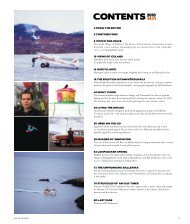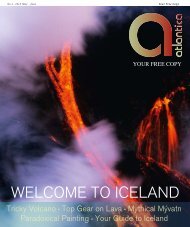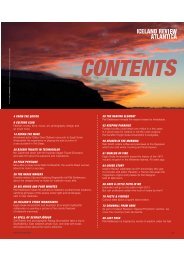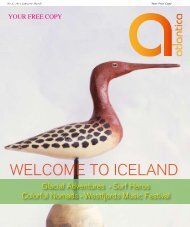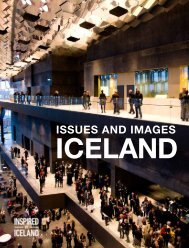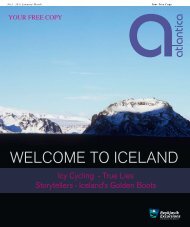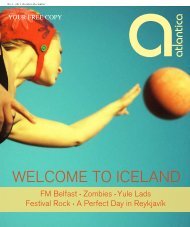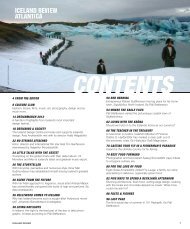Atlantica No. 4, 2010, July-August - Iceland Review
Atlantica No. 4, 2010, July-August - Iceland Review
Atlantica No. 4, 2010, July-August - Iceland Review
- No tags were found...
Create successful ePaper yourself
Turn your PDF publications into a flip-book with our unique Google optimized e-Paper software.
a Countryside CultureBustarfell Folk Museum inVopnafjördur.The Salt Fish Museum in GrindavíkOn the south side of the Reykjanes peninsula, just a stone’s throw from the Blue Lagoon, is the smalland picturesque fishing town of Grindavík with a population of less than 3,000 people. Though smallin size, it is grand in historical stature. Back in the middle ages it was a major trading center and thescene of many a fierce pirate raid, and its coastline is the location of countless shipwrecks. The debrisof the two most recent can be spotted by taking a hike around the outskirts of the town. The town stillretains an active fishing fleet that specializes in salt fish, one of the reasons for its importance in thedays before refrigeration when salt fish was <strong>Iceland</strong>’s ‘oil’. Take a stroll along one of the most majesticharbors in the country and you will come upon the <strong>Iceland</strong>ic Salt Fish Museum, opened in 2002. Takeadvantage of a unique opportunity to learn about an industry that is integral to the social and economicdevelopment of this island nation.The museum boasts a striking exhibition on the daily and yearly struggle for survival of this salt-ofthe-earthindustry and of the many people associated with it. The exhibition reveals, though life likerecreations, the treacherous sea voyages and the salting process. Visitors can take the guided audiotour, available in four different languages, to enhance the Salt Fish Museum experience.Opening hours: every day 11 a.m. – 6 p.m.Bustarfell ancestral farm at Hofsárdalurvalley in the east of the island encapsulates<strong>Iceland</strong>ic rural history at its moststunning. It is perhaps one of the oldestand best preserved farm houses ofits kind in the entire country. It is thequintessential 18th-century rural dwellinghome complete with red gables andturf roof. To visit the museum is to takean unforgettable journey through thehistory of <strong>Iceland</strong>ic farming. The exhibitsalso provide a rich insight into the changinglifestyles of rural <strong>Iceland</strong>ers over thelast 200 years. In 1532, Bustarfell wasbought by Árni Brandsson, son of thevicar at Höfn in Vopnafjördur and his wifeÚlfheidur, whose tombstone is preservedin the National Museum of <strong>Iceland</strong>. Sincethen the farmhouse was inhabited byan unbroken line of descendants until1966, when the house was preserved asa national treasure for posterity. Everyyear more and more artifacts are donatedto the museum’s collection which enrichthe exhibitions of local rural life in timespast. In 2006 the Croft Café visitor centerwas established to improve services forguests, taking its name from the tenantfarmers of crofters who worked the landand lived in small turf cottages.Opening hours: 10 June – 10 September 10a.m. – 6 p.m.46 atlantica



